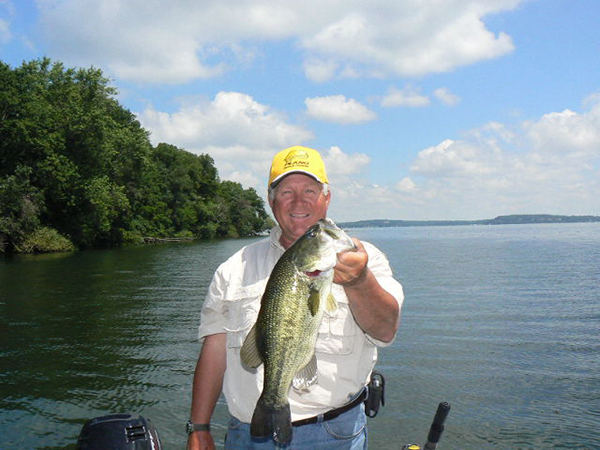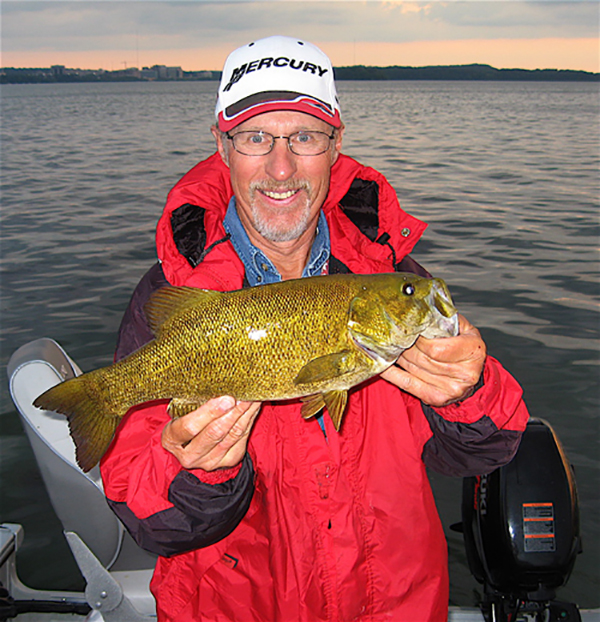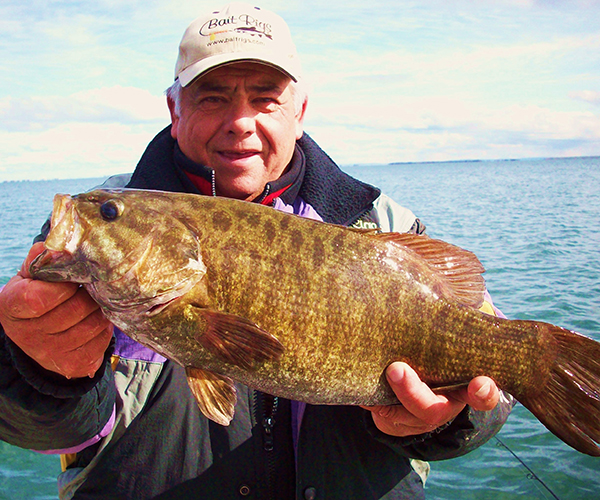Madison’s Lake Mendota and Lake Monona Pre-Spawn Bass
Gary Engberg Outdoors
There are five lakes in the Madison Chain of Lakes. They are Lake’s Mendota, Monona, Wabesa, Kegonsa, and Wingra. All of these metro lakes that surround Madison have good populations of both smallmouth and largemouth bass. There are chances of catching a trophy in any of the 5 lakes, particularly in early spring. Mendota is a better smallmouth lake and Monona is a better largemouth lake, though both species are present in both waters. I fished Lake Mendota for bass long before I started chasing walleyes. A friend of mine, Jim Weston, (now one of the best guides in Vilas County and Boulder Junction area (715 385-2774) lived then with his parents on Lake Mendota’s Dingles Bay, just east of the Tenney Park and the locks. This small bay had a muck bottom, many piers, and warmed faster than the rest of the lake. May and June are the best months to fish these lakes for bass with the largemouth spawning a few weeks before the smallmouth The spawning starts in May and continues into June in most of south-central Wisconsin lakes.

Guide Ron Barefield with a Madison average largemouth bass.
In both Mendota and Monona, the water temperature has to be in the 50’s for the bass to move into the shallower and warmer water. Monona, being shallower than Mendota and with Madison Gas and Electronic having a discharge on the north shore not far from the Yahara River, bass in general will start becoming active in May and peek in June. The largemouth will bite sooner in Monona because it warms quicker.
Here’s the low down on Lake Mendota’s largemouth fishery. The largemouth bass in Lake Mendota relate to the one thing that this 10,000-acre lake has plenty of and that is vegetation. Weed edges, weed lines, and weed beds will all produce fish. Finding the spots that warm up quicker will help you target the bass when they are in shallow water. Shallow bays that are protected from the wind, with dark or mud bottoms (which warm quicker), and vegetation are the ones to check out first. Also. fish the north shorelines because they receive more sun and thus warm quicker. A few degrees is a big jump for fish. The other prime spots are boat piers (holds true for Monona too), which line the lakes shoreline. Wooden piers are much better than metal too because the wood seems to grow algae which brings in the plankton and then the baitfish and so on.
Barefield with a Lake Mendota smallmouth.
The early pre-spawn hot spots are; the shallow weeds and wood of University Bay, Warner Bay, the weed line on the inside of Maple Bluff, and the weeds that run from the Tenny Park Locks to the University shoreline. Early pre-spawn bass have to be worked slowly like any fish coming out of the winter slows. A pre-rigged worm like the Wally Worm or lizards and worms Texas or Carolina rigged and slowly dragged are one of the best early baits. Slowly rolled spinner baits and twitching a crank baits (like the Mann’s Loudmouth Jerk or the Minus One Series) work well. The colors in worms that I like are black, purple, and motor oil. Later in the year, perch and fire tiger should be tried when the perch of year have grown.
Lake Monona is one of the chain’s best largemouth lakes. As I said before, start fishing Monona when the water is 50 degrees and above which will be a few weeks before the big lake (Mendota) This is another drainage lake with water coming from Mendota by way of the Yahara River, from the Starkweather Creek on the northeast, and Murphy Creek from Lake Wingra on the southwest side. There are weeds along most of the shoreline with milfoil the most common followed by cabbage and coontail. There are also parts of the weed line that have sand grass down to 18 feet. Similar to Mendota, Monona has plenty of piers and docks, which hold bass all year. Cast your baits under and around all piers and try speed changes to trigger bass. Turville Bay, Squaw Bay, the Monona shoreline, Monona Bay, and the area where the Yahara dumps into the lake are all worth trying early in the year. Again, try using a jig and pig combo; rigged worms, and slowly rolling spinners work well. Experiment with colors till you find the one which they want that day. What worked yesterday may not work today. Most fishing this time of year will be in less than 8 feet of water and often in just 1 to 3 feet.

Pro Duffy Kopf with a Lake Mendota smallmouth.
When it comes to small mouth bass Lake Mendota is one of Wisconsin’s best. Smallmouth have become one of the primary species in Mendota and they continue to do well and grow in numbers. Again, smallmouths spawn later than largemouth. Although, the smallies use much of the same habitat as walleyes, they are active at least a month later Water temperatures in the 50’s are needed to get the fish active. Check out any rocky shorelines if they have scattered weeds in the area. Top picks are Second Point, Picnic Point, and Governors Island early in spring. These fish will move shallow before they go to their summer haunts, which can be over 30 feet. Rock piles, rock bars, and big rocks are what you are looking for later. Smallmouth can be found near weeds if there are rocks close by. Live bait will always work on these fish, but I’m stressing using artificial because you injure fewer fish that you are going to release anyway. Later in June, it’s tough to beat a jig and leech on a slip bobber for Mendota bronzebacks.
The smallmouth numbers in Monona are rising due to the fish’s adaptability and the Yahara River, which allows fish from Mendota to reach Monona. Smallmouths have done extremely well in all the Madison lakes. The keys are the good habitat, plenty of forage, good lake fertility, catch and release, and higher size limits. Smallmouths in Mendota have to be 18 inches and you may keep only one. Lake Monona allows you to keep 5 fish over 14 inches. You can see how Mendota is rated a trophy lake with the 18 inches minimum. Five-pound largemouth and smallmouth are common. Fish over 8 pounds are caught every year. Any of the lakes can produce trophy bass by any standards.

Pro and guide Tony Puccio with a couple of smallmouth chunks!
The equipment I use includes; a 61/2 or 7 foot G.Loomis rod (MBR783c) a good casting rod which is versatile enough for most presentations and long enough to make lengthy casts to spooky pre-spawn bass. A Daiwa or Garcia bait casting reel with 10 to 12 pound Stren Easy Cast in green or coffee to match the stained algae colored water. Bring an assortment of pre-rigged worms, jigs, spinners, and crank baits so you’re ready for anything old bucket mouth might want.
Contacts; D and S Bait (608) 241-4225 ask for Gene or Lee. There are numerous baitshops and both lakes have good boat landings. Guides; Tony Puccio, (608)-212-6464, Wally Banfi, (608)-643-9823, Terry Frey, (608)-220-6366, Lee Tauchen, (608)-444-2180, Ron Barefield, (608)-8388756, Pat Westberg, (608)-575-4759, and Gary Engberg, (608)-795-4208.











